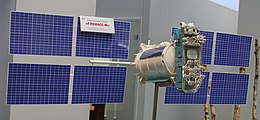cosmos.wikisort.org - Spacecraft
Kosmos 2516 (Russian: Космос 2516 meaning Space 2516) is a Russian military satellite launched in 2016 as part of the GLONASS satellite navigation system.
 Glonass-M satellite model | |
| Mission type | Navigation |
|---|---|
| Operator | Russian Aerospace Defence Forces |
| COSPAR ID | 2016-032A[1] |
| SATCAT no. | 41554[1] |
| Website | GLONASS status |
| Mission duration | Planned: 7 years Actual: 4 years, 5 months[2] |
| Spacecraft properties | |
| Spacecraft | GLONASS No. 753 |
| Spacecraft type | Uragan-M |
| Manufacturer | Reshetnev ISS[3] |
| Launch mass | 1,414 kilograms (3,117 lb) [3] |
| Dry mass | 250 kg[3] |
| Dimensions | 1.3 metres (4 ft 3 in) diameter [3] |
| Start of mission | |
| Launch date | May 29, 2016, 08:44 UTC |
| Rocket | Soyuz-2.1b/Fregat[3][4] |
| Launch site | Plesetsk 43/4 |
| Contractor | Russian Aerospace Defence Forces |
| End of mission | |
| Last contact | November 2020[2] |
| Orbital parameters | |
| Reference system | Geocentric |
| Regime | Medium Earth orbit |
| Semi-major axis | 25,508 km (15,850 mi)[1] |
| Eccentricity | 0.0011362[1] |
| Perigee altitude | 19,159 km (11,905 mi)[1] |
| Apogee altitude | 19,101 km (11,869 mi)[1] |
| Inclination | 64.70 degrees[1] |
| Period | 675.7 minutes[1] |
| Epoch | 30 January 2017 |
This satellite is a GLONASS-M satellite, also known as Uragan-M, and is numbered Uragan-M No. 753.[4]
Kosmos 2516 was launched from Site 43/4 at Plesetsk Cosmodrome in northern Russia. A Soyuz-2-1b carrier rocket with a Fregat upper stage was used to perform the launch which took place at 08:44 UTC on 29 May 2016. The launch successfully placed the satellite into a Medium Earth orbit. It subsequently received its Kosmos designation, and the international designator 2016-032A. The United States Space Command assigned it the Satellite Catalog Number 41554.[1]
The satellite is in orbital plane 2, in orbital slot 11.[5]
Kosmos 2516 experienced a depressurization event in November 2020, which permanently disabled the satellite after four years in service. GLONASS-K 15 (No. 705), launched on 25 October 2020, was repurposed as its replacement.[2]
See also
- 2016 in spaceflight
- List of Kosmos satellites (2501–2750)
- List of R-7 launches (2015–19)
References
- "LIVE REAL TIME SATELLITE TRACKING AND PREDICTIONS: COSMOS 2516 (GLONASS)". n2yo.com. Retrieved January 30, 2017.
- "Новейший "Глонасс-К" сменит вышедший из строя аппарат, рассказал источник" [Newest Glonass-K to replace failed satellite, source says]. RIA Novosti (in Russian). December 26, 2020. Retrieved December 27, 2020.
- Anatoly Zak. "GLONASS network". RussiaSpaceWeb.com. Retrieved January 30, 2017.
- Stephen Clark (May 31, 2016). "Russia's navigation network receives new satellite". Spaceflight Now. Retrieved January 30, 2017.
- "GLONASS constellation status, 30.01.2017". Information-analytical centre, Korolyov, Russia. January 30, 2017. Retrieved January 30, 2017.
Другой контент может иметь иную лицензию. Перед использованием материалов сайта WikiSort.org внимательно изучите правила лицензирования конкретных элементов наполнения сайта.
WikiSort.org - проект по пересортировке и дополнению контента Википедии